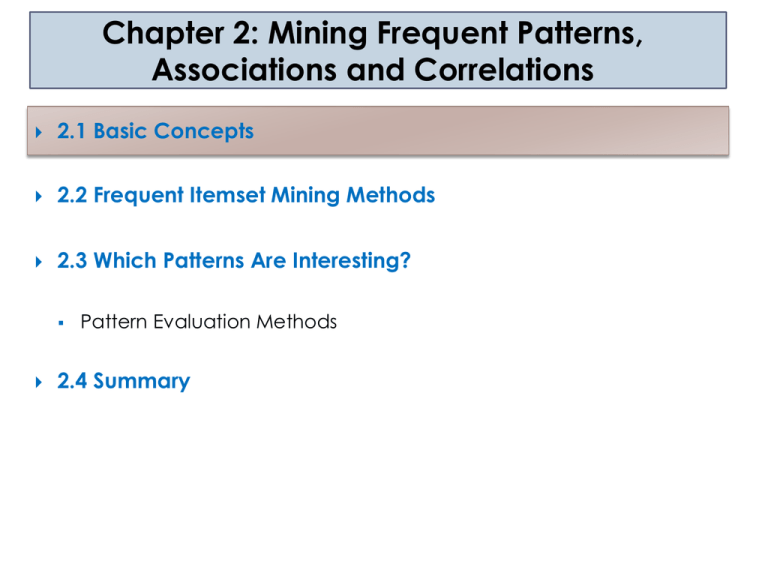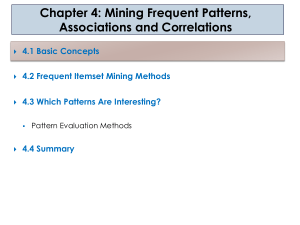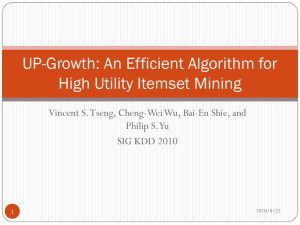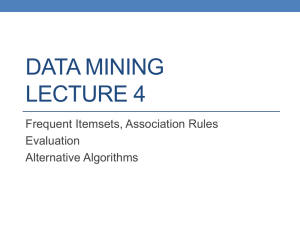slides
advertisement

Chapter 2: Mining Frequent Patterns,
Associations and Correlations
2.1 Basic Concepts
2.2 Frequent Itemset Mining Methods
2.3 Which Patterns Are Interesting?
Pattern Evaluation Methods
2.4 Summary
Frequent Pattern Analysis
Frequent Pattern: a pattern (a set of items, subsequences,
substructures, etc.) that occurs frequently in a data set
Goal: finding inherent regularities in data
What products were often purchased together?— Beer and
diapers?!
What are the subsequent purchases after buying a PC?
What kinds of DNA are sensitive to this new drug?
Can we automatically classify Web documents?
Applications:
Basket data analysis, cross-marketing, catalog design, sale
campaign analysis, Web log (click stream) analysis, and DNA
sequence analysis.
Why is Frequent Pattern Mining Important?
An important property of datasets
Foundation for many essential data mining tasks
Association, correlation, and causality analysis
Sequential, structural (e.g., sub-graph) patterns
Pattern analysis in spatiotemporal, multimedia, time-series, and
stream data
Classification: discriminative, frequent pattern analysis
Clustering analysis: frequent pattern-based clustering
Data warehousing: iceberg cube and cube-gradient
Semantic data compression
Broad applications
Frequent Patterns
Tid
Items bought
10
Beer, Nuts, Diaper
20
Beer, Coffee, Diaper
30
Beer, Diaper, Eggs
40
Nuts, Eggs, Milk
50
Nuts, Coffee, Diaper, Eggs, Milk
Customer
buys both
Customer
buys beer
itemset: A set of one or more items
K-itemset X = {x1, …, xk}
(absolute) support, or, support count
of X: Frequency or occurrence of an
itemset X
(relative) support, s, is the fraction of
transactions that contains X (i.e., the
probability that a transaction
contains X)
An itemset X is frequent if X’s support
is no less than a minsup threshold
Customer
buys diaper
Association Rules
Tid
Items bought
10
Beer, Nuts, Diaper
20
Beer, Coffee, Diaper
30
Beer, Diaper, Eggs
40
Nuts, Eggs, Milk
50
Nuts, Coffee, Diaper, Eggs, Milk
Customer
buys both
Customer
buys diaper
Find all the rules X Y with minimum
support and confidence threshold
support , s, probability that a
transaction contains X Y
confidence, c, conditional
probability that a transaction having
X also contains Y
Let minsup = 50%, minconf = 50%
Freq. Pat.: Beer:3, Nuts:3, Diaper:4,
Eggs:3, {Beer, Diaper}:3
Association rules: (many more!)
Customer
buys beer
Beer Diaper (60%, 100%)
Diaper Beer (60%, 75%)
Rules that satisfy both minsup and
minconf are called strong rules
Closed Patterns and Max-Patterns
A long pattern contains a combinatorial number of sub-patterns,
e.g., {a1, …, a100} contains (1001) + (1002) + … + (110000) = 2100 – 1 =
1.27*1030 sub-patterns!
Solution: Mine closed patterns and max-patterns instead
An itemset X is closed if X is frequent and there exists no superpattern Y כX, with the same support as X
An itemset X is a max-pattern if X is frequent and there exists no
frequent super-pattern Y כX
Closed pattern is a lossless compression of freq. patterns
Reducing the number of patterns and rules
Closed Patterns and Max-Patterns
Example
DB = {<a1, …, a100>, < a1, …, a50>}
Min_sup=1
What is the set of closed itemset?
What is the set of max-pattern?
<a1, …, a100>: 1
< a1, …, a50>: 2
<a1, …, a100>: 1
What is the set of all patterns?
!!
Computational Complexity
How many itemsets are potentially to be generated in the worst
case?
The number of frequent itemsets to be generated is sensitive to the
minsup threshold
When minsup is low, there exist potentially an exponential number of
frequent itemsets
The worst case: MN where M: # distinct items, and N: max length
of transactions
Chapter 2: Mining Frequent Patterns,
Associations and Correlations
2.1 Basic Concepts
2.2 Frequent Itemset Mining Methods
2.2.1
2.2.2
2.2.3
2.2.4
2.3 Which Patterns Are Interesting?
Apriori: A Candidate Generation-and-Test Approach
Improving the Efficiency of Apriori
FPGrowth: A Frequent Pattern-Growth Approach
ECLAT: Frequent Pattern Mining with Vertical Data Format
Pattern Evaluation Methods
2.4 Summary
2.2.1 Apriori: Concepts and Principle
The downward closure property of frequent patterns
Any subset of a frequent itemset must be frequent
If {beer, diaper, nuts} is frequent, so is {beer, diaper}
i.e., every transaction having {beer, diaper, nuts} also contains
{beer, diaper}
Apriori pruning principle: If there is any itemset which is infrequent,
its superset should not be generated/tested
Apriori Principle
Initially, scan DB once to get frequent 1-itemset
Generate length (k+1) candidate itemsets from length k frequent
itemsets
Test the candidates against DB
Terminate when no frequent or candidate set can be generated
Apriori: Example
Supmin = 2
Itemset
sup
{I1}
2
C1
{I2}
3
{I3}
3
scan
{I4}
1
{I5}
3
Database
Tid
Items
10
I1, I3, I4
20
I2, I3, I5
30
I1, I2, I3, I5
40
I2, I5
1st
C2
L2
Itemset
{I1, I3}
sup
2
{I2, I3}
{I2, I5}
2
3
{I3, I5}
2
Itemset
sup
{I1}
2
{I2}
3
{I3}
3
{I5}
3
L1
Itemset
{I1, I2}
sup
1
{I1, I3}
{I1, I5}
2
1
{I2, I3}
2
{I1, I5}
{I2, I5}
3
{I2, I3}
{I3, I5}
2
{I2, I5}
C2
2nd scan
Itemset
{I1, I2}
{I1, I3}
{I3, I5}
C3
Itemset
{I2, I3, I5}
3rd
scan
L3
Itemset
sup
{I2, I3, I5}
2
Apriori Algorithm
Ck: Candidate itemset of size k
Lk : frequent itemset of size k
L1 = {frequent items};
for (k = 1; Lk !=; k++) do begin
Ck+1 = candidates generated from Lk;
for each transaction t in database do
increment the count of all candidates in Ck+1 that are
contained in t
Lk+1 = candidates in Ck+1 with min_support
end
return k Lk;
Candidate Generation
How to generate candidates?
Step 1: self-joining Lk
Step 2: pruning
Join Lk p with Lk q, as follows:
insert into Ck+1
select {p.itemi}{1,..,k-1}, p.itemk, q.itemk
from Lk p, Lk q
where {p.itemi}{1,..k-1} = {q.itemi} {1,..k-1} and p.itemk < q.itemk
Example of Candidate Generation
Suppose we have the following frequent 3-itemsets and we would
like to generate the 4-itemsets candidates
L3={{I1, I2, I3} , {I1, I2, I4}, {I1, I3, I4}, {I1, I3, I5}, {I2,I3,I4}}
Self-joining: L3*L3 gives:
{I1,I2,I3,I4} from {I1, I2, I3} , {I1, I2, I4}, and {I2,I3,I4}
{I1,I3,I4,I5} from {I1, I3, I4} and {I1, I3, I5}
Pruning: {I1,I3,I4,I5} is removed because {I1,I4,I5} is not in L3
C4 = {I1,I2,I3,I4}
Generating Association Rules
Once the frequent itemsets have been found, it is straightforward
to generate strong association rules that satisfy:
minimum support
minimum confidence
Relation between support and confidence:
support_count(AB)
Confidence(AB) = P(B|A)=
support_count(A)
Support_count(AB) is the number of transactions containing the
itemsets A B
Support_count(A) is the number of transactions containing the
itemset A.
Generating Association Rules
For each frequent itemset L, generate all non empty subsets of L
For every non empty subset S of L, output the rule:
S (L-S)
If (support_count(L)/support_count(S)) >= min_conf
Example
Suppose the frequent Itemset
L={I1,I2,I5}
Subsets of L are: {I1,I2},
{I1,I5},{I2,I5},{I1},{I2},{I5}
Association rules :
I1 I2 I5
confidence = 2/4= 50%
I1 I5 I2
confidence=2/2=100%
I2 I5 I1
confidence=2/2=100%
I1 I2 I5
confidence=2/6=33%
I2 I1 I5
confidence=2/7=29%
I5 I2 I2
confidence=2/2=100%
If the minimum confidence =70%
Question: what is the difference between
association rules and decision tree rules?
Transactional Database
TID
List of item IDS
T100
I1,I2,I5
T200
I2,I4
T300
I2,I3
T400
I1,I2,I4
T500
I1,I3
T600
I2,I3
T700
I1,I3
T800
I1,I2,I3,I5
T900
I1,I2,I3
2.2.2 Improving the Efficiency of Apriori
Major computational challenges
Huge number of candidates
Multiple scans of transaction database
Tedious workload of support counting for candidates
Improving Apriori: general ideas
Shrink number of candidates
Reduce passes of transaction database scans
Facilitate support counting of candidates
(A) DHP: Hash-based Technique
Database
Tid
Items
10
A, C, D
20
B, C, E
30
A, B, C, E
40
B, E
C1
Itemset
sup
{A}
2
{B}
3
{C}
3
{D}
1
{E}
3
1st scan
Making a hash table
10: {A,C}, {A, D}, {C,D}
Hash codes
Buckets
Buckets
counters
min-support=2
We have the
following
binary vector
20: {B,C}, {B, E}, {C,E}
30: {A,B}, {A, C}, {A,E}, {B,C}, {B, E}, {C,E} 40: {B, E}
0
{C,E}
{C,E}
{A, B}
1
{A,E}
2
{B,C}
{B,C}
3
4
{B,E}
{B,E}
{B,E}
5
6
{A,C}
{A,C}
3
1
2
0
3
0
2
1
0
{A,B}
{A, C}
{B,C}
{B, E}
{C,E}
1
0
1
2
2
3
2
1
0
1
{A, C}
{B,C}
{B, E}
{C,E}
J. Park, M. Chen, and P. Yu. An effective hash-based algorithm for mining association rules. SIGMOD’95
(A) DHP: Hash-based Technique
Database
Tid
Items
10
I1,I3, I4
20
I2, I3, I5
30
I1, I2, I3, I5
40
I2, I5
C1
Itemset
sup
Tid
Items
{I1}
2
10
{I1,I3}, {I1, I4}, {I3,I4}
{I2}
3
20
{I2, I3}, {I2, I5}, {I3,I5}
{I3}
3
30
{I4}
1
{I1, I2},{I1, I3}, {I1,I5}, {I2,I3},
{I2,I5}, {I3,I5}
{I5}
3
40
{I2, I5}
1st scan
At the same time of counting the support of Itemet-1, generate itemset2
Make a hash table using: h({x,y})= ((order of x)*10 + (order of y)) mod 7
Hash codes
Buckets
Buckets
counters
min-support=2
We have the
following
binary vector
0
{I3,I5}
{I3,I5}
{I1, I4}
1
{I1,I5}
2
{I2,I3}
{I2,I3}
3
4
{I2,I5}
{I2,I5}
{I2,I5}
5
{I1,I2}
6
{I1,I3}
{I3,I4}
{I1,I3}
3
1
2
0
3
1
3
1
0
1
L1 ×L1
0
{I1,I2}
{I1, I3}
{I1,I5}
{I2,I3}
{I2,I5}
{I3,I5}
1
3
1
2
3
3
1
0
1
{I1, I3}
{I2,I3}
{I2, I5}
{I3,I5}
J. Park, M. Chen, and P. Yu. An effective hash-based algorithm for mining association rules. SIGMOD’95
(B) Partition: Scan Database Only Twice
Subdivide the transactions of D into k non overlapping partitions
Any itemset that is potentially frequent in D must be frequent in at
least one of the partitions Di
Each partition can fit into main memory, thus it is read only once
Steps:
Scan1: partition database and find local frequent patterns
Scan2: consolidate global frequent patterns
D1
+
D2
+
+
Dk
A. Savasere, E. Omiecinski and S. Navathe, VLDB’95
=
D
(C) Sampling for Frequent Patterns
Select a sample of the original database
Mine frequent patterns within the sample using Apriori
Use a lower support threshold than the minimum support to find
local frequent itemsets
Scan the database once to verify the frequent itemsets found in
the sample
Only broader frequent patterns are checked
Example: check abcd instead of ab, ac,…, etc.
Scan the database again to find missed frequent patterns
H. Toivonen. Sampling large databases for association rules. In VLDB’96
(D) Dynamic: Reduce Number of Scans
ABCD
ABC ABD ACD BCD
AB
AC
BC
AD
BD
CD
Apriori
A
B
C
D
{}
Itemset lattice
Once both A and D are determined
frequent, the counting of AD begins
Once all length-2 subsets of BCD are
determined frequent, the counting of
BCD begins
Transactions
1-itemsets
2-itemsets
…
1-itemsets
2-items
DIC
3-items
S. Brin R. Motwani, J. Ullman, and S. Tsur. Dynamic itemset counting and implication rules for market basket
data. In SIGMOD’97
2.2.3 FP-growth: Frequent Pattern-Growth
Adopts a divide and conquer strategy
Compress the database representing frequent items into a
frequent –pattern tree or FP-tree
Retains the itemset association information
Divid the compressed database into a set of conditional
databases, each associated with one frequent item
Mine each such databases separately
Example: FP-growth
The first scan of data is the
same as Apriori
Derive the set of frequent 1itemsets
Let min-sup=2
Generate a set of ordered
items
Transactional Database
TID
List of item IDS
T100
I1,I2,I5
T200
I2,I4
T300
I2,I3
T400
I1,I2,I4
T500
I1,I3
T600
I2,I3
T700
I1,I3
Item ID
Support
count
I2
7
T800
I1,I2,I3,I5
I1
6
T900
I1,I2,I3
I3
6
I4
2
I5
2
Construct the FP-Tree
Transactional Database
TID
Items
TID
Items
TID
Items
T100
I1,I2,I5
T400
I1,I2,I4
T700
I1,I3
T200
I2,I4
T500
I1,I3
T800
I1,I2,I3,I5
T300
I2,I3
T600
I2,I3
T900
I1,I2,I3
- Create a branch for each
transaction
- Items in each transaction are
processed in order
Item ID
Support
count
I2
7
I1
6
I3
6
I4
2
I5
2
1- Order the items T100: {I2,I1,I5}
2- Construct the first branch:
<I2:1>, <I1:1>,<I5:1>
null
I2:1
I1:1
I5:1
Construct the FP-Tree
Transactional Database
TID
Items
TID
Items
TID
Items
T100
I1,I2,I5
T400
I1,I2,I4
T700
I1,I3
T200
I2,I4
T500
I1,I3
T800
I1,I2,I3,I5
T300
I2,I3
T600
I2,I3
T900
I1,I2,I3
- Create a branch for each
transaction
- Items in each transaction are
processed in order
Item ID
Support
count
I2
7
I1
6
I3
6
I4
2
I5
2
1- Order the items T200: {I2,I4}
2- Construct the second branch:
<I2:1>, <I4:1>
null
I2:2
I2:1
I1:1
I5:1
I4:1
Construct the FP-Tree
Transactional Database
TID
Items
TID
Items
TID
Items
T100
I1,I2,I5
T400
I1,I2,I4
T700
I1,I3
T200
I2,I4
T500
I1,I3
T800
I1,I2,I3,I5
T300
I2,I3
T600
I2,I3
T900
I1,I2,I3
- Create a branch for each
transaction
- Items in each transaction are
processed in order
Item ID
Support
count
I2
7
I1
6
I3
6
I4
2
I5
2
1- Order the items T300: {I2,I3}
2- Construct the third branch:
<I2:2>, <I3:1>
null
I2:2
I2:3
I4:1
I1:1
I3:1
I5:1
Construct the FP-Tree
Transactional Database
TID
Items
TID
Items
TID
Items
T100
I1,I2,I5
T400
I1,I2,I4
T700
I1,I3
T200
I2,I4
T500
I1,I3
T800
I1,I2,I3,I5
T300
I2,I3
T600
I2,I3
T900
I1,I2,I3
- Create a branch for each
transaction
- Items in each transaction are
processed in order
Item ID
Support
count
I2
7
I1
6
I3
6
I4
2
I5
2
1- Order the items T400: {I2,I1,I4}
2- Construct the fourth branch:
<I2:3>, <I1:1>,<I4:1>
null
I2:4
I2:3
I4:1
I1:2
I1:1
I3:1
I5:1
I4:1
Construct the FP-Tree
Transactional Database
TID
Items
TID
Items
TID
Items
T100
I1,I2,I5
T400
I1,I2,I4
T700
I1,I3
T200
I2,I4
T500
I1,I3
T800
I1,I2,I3,I5
T300
I2,I3
T600
I2,I3
T900
I1,I2,I3
- Create a branch for each
transaction
- Items in each transaction are
processed in order
Item ID
Support
count
I2
7
I1
6
I3
6
I4
2
I5
2
1- Order the items T400: {I1,I3}
2- Construct the fifth branch:
<I1:1>, <I3:1>
null
I1:1
I2:4
I4:1
I1:2
I3:1
I5:1
I4:1
I3:1
Construct the FP-Tree
Transactional Database
TID
Items
TID
Items
TID
Items
T100
I1,I2,I5
T400
I1,I2,I4
T700
I1,I3
T200
I2,I4
T500
I1,I3
T800
I1,I2,I3,I5
T300
I2,I3
T600
I2,I3
T900
I1,I2,I3
null
Item ID
Support
count
I2
7
I1
6
I3
6
I4
2
I5
2
I1:2
I2:7
I4:1
I1:4
I3:2
I3:2
I5:1
I4:1
I3:2
I5:1
When a branch of a
transaction is added, the
count for each node
along a common prefix is
incremented by 1
Construct the FP-Tree
null
I2:7
Item ID
Support
count
I2
7
I1
6
I3
6
I4
2
I5
2
I1:2
I1:4
I4:1
I3:2
I5:1
I4:1
I3:2
I5:1
The problem of mining frequent patterns in databases is
transformed to that of mining the FP-tree
I3:2
Construct the FP-Tree
null
I2:7
Item ID
Support
count
I2
7
I1
6
I3
6
I4
2
I5
2
I1:2
I1:4
I4:1
I3:2
I5:1
I4:1
I3:2
I5:1
-Occurrences of I5: <I2,I1,I5> and <I2,I1,I3,I5>
-Two prefix Paths <I2, I1: 1> and <I2,I1,I3: 1>
-Conditional FP tree contains only <I2: 2, I1: 2>, I3 is not
considered because its support count of 1 is less than the
minimum support count.
-Frequent patterns {I2,I5:2}, {I1,I5:2},{I2,I1,I5:2}
I3:2
Construct the FP-Tree
null
Item ID
Support
count
I2
I1
I3
I4
I5
7
6
6
2
2
I2:7
I1:2
I1:4
I4:1
I3:2
I5:1
I4:1
I3:2
I5:1
TID
Conditional Pattern Base
Conditional FP-tree
I5
{{I2,I1:1},{I2,I1,I3:1}}
<I2:2,I1:2>
I4
{{I2,I1:1},{I2,1}}
<I2:2>
I3
{{I2,I1:2},{I2:2}, {I1:2}}
<I2:4,I1:2>,<I1:2>
I1
{I2,4}
<I2:4>
I3:2
Construct the FP-Tree
null
Item ID
Support
count
I2
I1
I3
I4
I5
7
6
6
2
2
I2:7
I1:2
I1:4
I4:1
I3:2
I5:1
I4:1
I3:2
I5:1
TID
Conditional FP-tree
Frequent Patterns Generated
I5
<I2:2,I1:2>
{I2,I5:2}, {I1,I5:2},{I2,I1,I5:2}
I4
<I2:2>
{I2,I4:2}
I3
<I2:4,I1:2>,<I1:2>
{I2,I3:4},{I1,I3:4},{I2,I1,I3:2}
I1
<I2:4>
{I2,I1:4}
I3:2
FP-growth properties
FP-growth transforms the problem of finding long frequent patterns
to searching for shorter once recursively and concatenating the
suffix
It uses the least frequent suffix offering a good selectivity
It reduces the search cost
If the tree does not fit into main memory, partition the database
Efficient and scalable for mining both long and short frequent
patterns
2.2.4 ECLAT: FP Mining with Vertical Data Format
Both Apriori and FP-growth use horizontal data format
TID
List of item IDS
T100
I1,I2,I5
T200
I2,I4
T300
I2,I3
T400
I1,I2,I4
T500
I1,I3
T600
I2,I3
T700
I1,I3
T800
I1,I2,I3,I5
T900
I1,I2,I3
Alternatively data can also be represented in vertical format
itemset
TID_set
I1
{T100,T400,T500,T700,T800,T900}
I2
{T100,T200,T300,T400,T600,T800,T900}
I3
{T300,T500,T600,T700,T800,T900}
I4
{T200,T400}
I5
{T100,T800}
ECLAT Algorithm by Example
Transform the horizontally formatted data to the vertical format
by scanning the database once
TID
List of item IDS
T100
I1,I2,I5
T200
I2,I4
T300
I2,I3
T400
I1,I2,I4
T500
I1,I3
T600
I2,I3
T700
I1,I3
T800
I1,I2,I3,I5
T900
I1,I2,I3
itemset
TID_set
I1
{T100,T400,T500,T700,T800,T900}
I2
{T100,T200,T300,T400,T600,T800,T900}
I3
{T300,T500,T600,T700,T800,T900}
I4
{T200,T400}
I5
{T100,T800}
The support count of an itemset is simply the length of the TID_set
of the itemset
ECLAT Algorithm by Example
Frequent 1-itemsets in vertical format
min_sup=2
itemset
TID_set
I1
{T100,T400,T500,T700,T800,T900}
I2
{T100,T200,T300,T400,T600,T800,T900}
I3
{T300,T500,T600,T700,T800,T900}
I4
{T200,T400}
I5
{T100,T800}
The frequent k-itemsets can be used to construct the candidate
(k+1)-itemsets based on the Apriori property
Frequent 2-itemsets in vertical format
itemset
TID_set
{I1,I2}
{T100,T400,T800,T900}
{I1,I3}
{T500,T700,T800,T900}
{I1,I4}
{T400}
{I1,I5}
{T100,T800}
{I2,I3}
{T300,T600,T800,T900}
{I2,I4}
{T200,T400}
{I2,I5}
{T100,T800}
{I3,I5}
{T800}
ECLAT Algorithm by Example
Frequent 3-itemsets in vertical format
min_sup=2
itemset
TID_set
{I1,I2,I3}
{T800,T900}
{I1,I2,I5}
{T100,T800}
This process repeats, with k incremented by 1 each time, until no
frequent items or no candidate itemsets can be found
Properties of mining with vertical data format
Take the advantage of the Apriori property in the generation of
candidate (k+1)-itemset from k-itemsets
No need to scan the database to find the support of (k+1)
itemsets, for k>=1
The TID_set of each k-itemset carries the complete information
required for counting such support
The TID-sets can be quite long, hence expensive to manipulate
Use diffset technique to optimize the support count computation
Chapter 2: Mining Frequent Patterns,
Associations and Correlations
2.1 Basic Concepts
2.2 Frequent Itemset Mining Methods
2.2.1
2.2.2
2.2.3
2.2.4
2.3 Which Patterns Are Interesting?
Apriori: A Candidate Generation-and-Test Approach
Improving the Efficiency of Apriori
FPGrowth: A Frequent Pattern-Growth Approach
ECLAT: Frequent Pattern Mining with Vertical Data Format
Pattern Evaluation Methods
2.4 Summary
Strong Rules Are Not Necessarily Interesting
Whether a rule is interesting or not can be assessed either
subjectively or objectively
Objective interestingness measures can be used as one step
toward the goal of finding interesting rules for the user
Example of a misleading “strong” association rule
Analyze transactions of AllElectronics data about computer
games and videos
Of the 10,000 transactions analyzed
6,000 of the transactions include computer games
7,500 of the transactions include videos
4,000 of the transactions include both
Suppose that min_sup=30% and min_confidence=60%
The following association rule is discovered:
Buys(X, “computer games”) buys(X, “videos”)[support =40%, confidence=66%]
Strong Rules Are Not Necessarily Interesting
Buys(X, “computer games”) buys(X, “videos”)[support 40%, confidence=66%]
This rule is strong but it is misleading
The probability of purshasing videos is 75% which is even larger
than 66%
In fact computer games and videos are negatively associated
because the purchase of one of these items actually decreases
the likelihood of purchasing the other
The confidence of a rule A B can be deceiving
It is only an estimate of the conditional probability of itemset B
given itemset A.
It does not measure the real strength of the correlation implication
between A and B
Need to use Correlation Analysis
From Association to Correlation Analysis
Use Lift, a simple correlation measure
The occurrence of itemset A is independent of the occurrence of
itemset B if P(AB)=P(A)P(B), otherwise itemsets A and B are
dependent and correlated as events
The lift between the occurences of A and B is given by
Lift(A,B)=P(AB)/P(A)P(B)
If > 1, then A and B are positively correlated (the occurrence of one
implies the occurrence of the other)
If <1, then A and B are negatively correlated
If =1, then A and B are independent
Example: P({game, video})=0.4/(0.60 0.75)=0.89
Chapter 2: Mining Frequent Patterns,
Associations and Correlations
2.1 Basic Concepts
2.2 Frequent Itemset Mining Methods
2.2.1
2.2.2
2.2.3
2.2.4
2.3 Which Patterns Are Interesting?
Apriori: A Candidate Generation-and-Test Approach
Improving the Efficiency of Apriori
FPGrowth: A Frequent Pattern-Growth Approach
ECLAT: Frequent Pattern Mining with Vertical Data Format
Pattern Evaluation Methods
2.4 Summary
2.4 Summary
Basic Concepts: association rules, support-confident framework,
closed and max patterns
Scalable frequent pattern mining methods
Apriori (Candidate generation & test)
Projection-based (FPgrowth)
Vertical format approach (ECLAT)
Interesting Patterns
Correlation analysis








